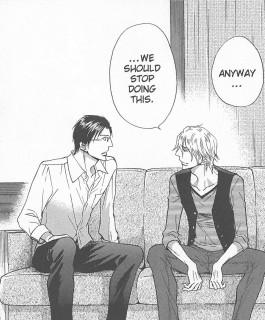 Creator: Fumi Yoshinaga
Creator: Fumi Yoshinaga
U.S. publisher: Vertical
ISBN: 9781941220221
Released: March 2015
Original release: 2012
What Did You Eat Yesterday? incorporates so many things that I love—the work of Fumi Yoshinaga, food, queer life, and so on—that it’s really not too much of a surprise that I enjoy the manga series. Yoshinaga has had many of her manga released in English. I have always been particularly impressed by the subtle complexities of her characterizations. Her skill at writing people is especially important for a series like What Did You Eat Yesterday? in which a tremendous amount of focus is given to the characters themselves rather than to an intricate, overarching plot, at least when the manga’s not focusing on food. The characters in What Did You Eat Yesterday?, likeable or not, are all very realistically portrayed, which is one of the things that I appreciate most about the series. What Did You Eat Yesterday?, Volume 7 was originally published in Japan in 2012. The English-language edition, released by Vertical, was published in 2015.
Shiro and Kenji have been living together for years, but it’s only recently that Shiro has managed to get up the courage to actually introduce his long-term boyfriend to his parents. It’s a momentous albeit awkward occasion, but Kenji at least is thrilled by the prospect. Shiro’s family has known he was gay for quite some time, however they are still coming to terms with exactly what that means. Happily, sharing a good meal can go a long way to help acceptance and understanding grow. Food has helped to improve and stabilize Kenji and Shiro’s relationship as well—Shiro enjoys cooking and Kenji is usually more than happy to accommodate his boyfriend, not to mention eat the fruits of his efforts—which is why when work interferes with their dinner dates at home it’s particularly vexing. The salon that Kenji works at is undergoing renovations and staffing changes while the law office where Shiro is employed is inundated with bankruptcy cases. Both men have been very busy of late, but they are still ready to support each other both inside the kitchen and outside of it.
 Food, and the preparation and consumption of said food, is a major component of What Did You Eat Yesterday?. A majority of the seventh volume, if not the entire series, is spent either cooking in a kitchen or eating around a table. While other aspects of Yoshinaga’s artwork are rather simple, she puts a tremendous amount of detail into the various dishes that are featured in the manga—the food in What Did You Eat Yesterday? is beautifully illustrated. The recipes in the series tend to be fairly detailed as well. It is entirely possible for an experienced cook to successfully recreate many of the courses. I’ve even been tempted to try a few myself. (The tea sorbet from the seventh volume sounds especially appealing to me.) Occasionally, the focus on food in What Did You Eat Yesterday? can get in the way of the stories being told, but sometimes it’s expertly integrated.
Food, and the preparation and consumption of said food, is a major component of What Did You Eat Yesterday?. A majority of the seventh volume, if not the entire series, is spent either cooking in a kitchen or eating around a table. While other aspects of Yoshinaga’s artwork are rather simple, she puts a tremendous amount of detail into the various dishes that are featured in the manga—the food in What Did You Eat Yesterday? is beautifully illustrated. The recipes in the series tend to be fairly detailed as well. It is entirely possible for an experienced cook to successfully recreate many of the courses. I’ve even been tempted to try a few myself. (The tea sorbet from the seventh volume sounds especially appealing to me.) Occasionally, the focus on food in What Did You Eat Yesterday? can get in the way of the stories being told, but sometimes it’s expertly integrated.
As much as I enjoy all of the food and eating What Did You Eat Yesterday? (and I certainly do), what really makes the series work for me are its characters and the realistic portrayal of their lives. I have come to love and care for the characters in the series a great deal in spite of, or maybe because of, their very human flaws. They all come across as real people with both good traits and bad. I enjoy seeing their relationships evolve and change, and I enjoy seeing them continue to grow as people well into their adulthood. The individual chapters of What Did You Eat Yesterday? provide small snapshots of the characters’ everyday lives. Sometimes the events shown are fairly ordinary or mundane, such as grocery shopping followed by a quick stop at a cafe, while others are more momentous, like meeting the parents of an established partner for the first time. But even the seemingly small and quiet moments in What Did You Eat Yesterday? are important, carrying signficant meaning and impact, and showing just how skilled a writer Yoshinaga can be.







